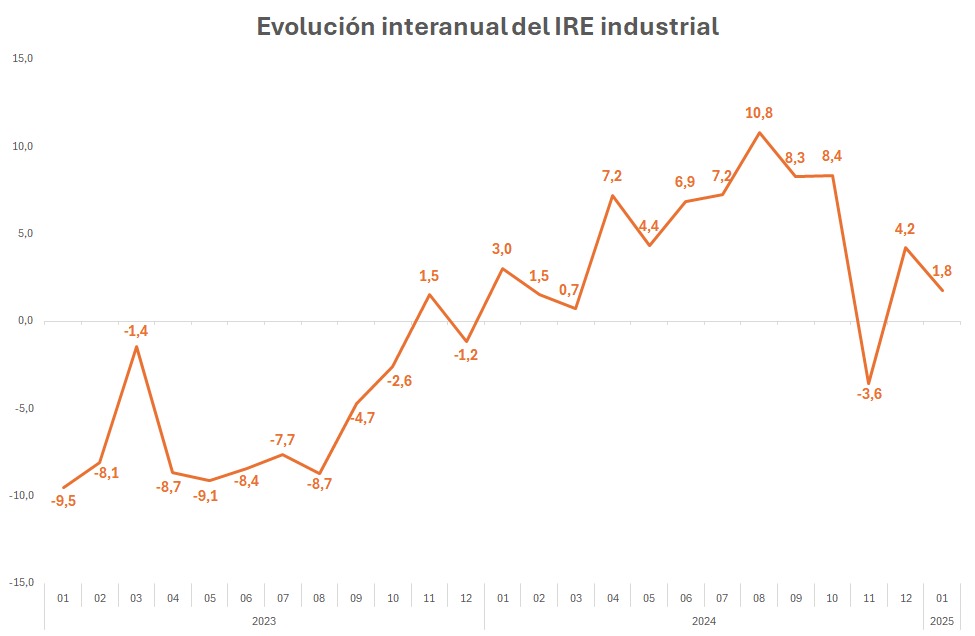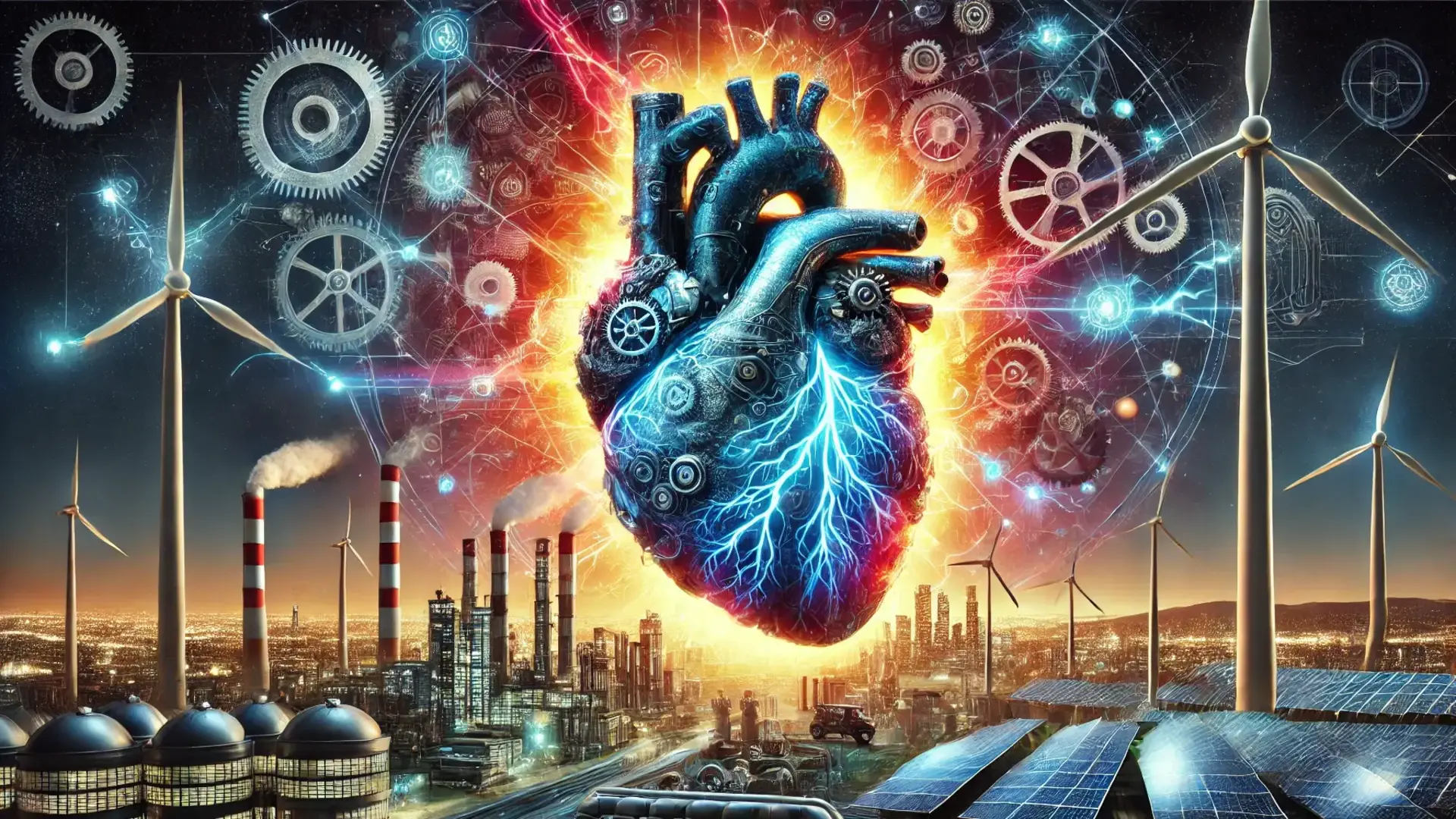-
The MITECO recognizes industry as a priority in the new cycle of electrical planning and has opened a public consultation on aid, which includes a specific section for “installation and integration costs, mainly for industry.”
-
Measures must be taken to prevent an energy heart attack.
Industry: The Beating Heart of the Economy
Imagine the economy as a living organism. Industry is its heart: a tireless muscle that pumps activity, employment, and value into every corner of the system. But for that heart to function, it needs an efficient circulatory system—robust, flexible, and modern energy networks that transport vital resources. Today, that system faces an unprecedented challenge.
According to analysis by Opina 360 based on provisional data from the Red Eléctrica Index (IRE), industrial energy demand grew by 1.8% in January 2025 compared to the previous year and reached 4.8% in December. Almost every month in 2024, except November, showed an increase in industrial energy demand. The Red Eléctrica Index (IRE) for industry is a leading indicator that measures the energy demand of medium and large consumers (with contracted power exceeding 450 kW), adjusted to eliminate distortions caused by temperature variations and work calendar changes.

Source: Opina 360 with provisional data from the Red Eléctrica Index
This growth is not incidental. The industrial sector represents 35.4% of national electricity consumption, according to Opina 360 data. These figures reflect a clear trend: Spanish industry is expanding, and with it, its energy demand. To sustain this growth, it is essential to have an energy system capable of optimizing consumption, ensuring flexibility, and guaranteeing resource availability. In other words, we need modern networks, efficient storage, and policies that support a productive muscle that never stops growing.
The Government Recognizes the Pulse: Energy Policies in Service of Industry
The Ministry for Ecological Transition and the Demographic Challenge appears to have listened to the industrial pulse. In recent statements, Vice President Sara Aagesen has emphasized the importance of retaining industry in Spain, preventing relocations, and ensuring competitiveness in an increasingly demanding global context. This stance is not new to Foro Industria y Energía, which has advocated from the outset that energy policy must go hand in hand with industrial policy.
“We want to understand the sector’s opinion and consider its contributions so that Spain’s position is clear when we reach Europe, with the goal of protecting and supporting our industrial productive sector.” —Sara Aagesen, Third Vice President and Minister for Ecological Transition and the Demographic Challenge
This shift in rhetoric is accompanied by tangible measures: the Vice President has highlighted the allocation of €1.2 billion within the Hydrogen Valleys program and expressed her willingness to reinstate the 80% reduction in electricity tolls for electro-intensive industries. Additionally, she announced a new €700 million aid call for energy storage.
The Ministry is committed to a comprehensive strategic vision, from energy production to consumption, with a focus on competitive energy costs and a renewable rollout that includes elements such as multiple CUPS contracts, closed networks, and an updated self-consumption framework. Regarding electrification and infrastructure, a new cycle of electrical planning is expected, including a review of investment limits and competitive bidding for generation and demand. “We have been able to announce to the sector that the priority will be the industrial sector,” Aagesen stated, referring to the future planning of transmission networks.
The Right Moment to Pump Out Solutions
This governmental recognition comes at a crucial time, coinciding with the opening of the prior public consultation on the proposal for an aid call for flexibility and demand management, funded by the FEDER 2021-2027 program. Foro Industria y Energía has seized this opportunity to present concrete proposals aimed at maximizing the impact of these funds on the industrial sector.
Our contribution, based on years of experience and sector expertise, seeks to ensure that this pulsating muscle of the economy has sufficiently sized arteries to support its growth. Because recognizing the importance of industry is one thing, but designing the right mechanisms to enhance its energy competitiveness is quite another.
Our proposals focus on six pillars:
- Industry as a Strategic Core: Allocate a specific budget for industrial projects, prioritizing large-scale installations and projects that integrate flexibility and on-site renewable generation. The future National Energy Commission could play a role in closely collaborating with industrial departments to align energy and industrial policies, improving sector competitiveness.
- Simplification of Requirements for SMEs and Energy-Intensive Sectors: Create a dedicated line for SMEs and provide free technical advisory services for project drafting.
- Support for Hard-to-Electrify Industries: Introduce tiered incentives based on emission reductions and promote disruptive technologies such as high-temperature electrolysis.
- Integration of Enabling Technologies: Define a catalog of priority technologies for industry and incentivize projects that combine flexibility and decarbonization.
- Clear Selection and Evaluation Criteria: Incorporate quantifiable metrics to assess emission reductions, energy efficiency, and replicability in other sectors.
- Timelines and Financing Adapted to Industrial Complexity: Extend project execution periods for industrial projects and implement milestone-based staggered payments.
These proposals are not wishful thinking. They are a roadmap to prevent an energy heart attack, ensuring that the system’s arteries—networks, storage, policies—can support the industry’s heartbeat.
A Robust Energy System for a Strong Heart
Industry beats strongly, but its vitality depends on an energy system that can keep up. The IRE data, Aagesen’s statements, and Foro Industria y Energía’s proposals converge on one message: it is time to act.
Modernizing networks, prioritizing storage, and aligning incentives are not optional; they are imperative. With rising energy demand and an increasingly competitive global landscape, it is crucial that energy policies recognize the central role of industry and act accordingly. Because without a strong heart and clear arteries, the Spanish economy cannot compete in a world where energy is the oxygen of progress.
Foro Industria y Energía will continue working to ensure that the industry’s voice is heard because only with a robust energy system can we guarantee that the heart of our economy keeps beating strongly.

